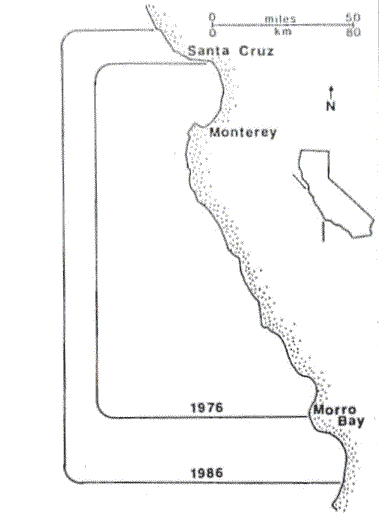 |
Last Update:
Friday November 23, 2018
|
| [Home] |
|
Volume 2 Pages 1 - 58 (March 1987) Citation: Ames. J.A.. (1987) The Current Status of the Sea Otter Population in California (December 1986) IUCN Otter Spec. Group Bull. 2: 21 - 25 The Current Status of the Sea Otter Population in California (December 1986) Jack Ames California Department of Fish and Game, 2201 Garden Road, Monterey CA 93940 U.S.A. Sea otters are counted directly (rather than indirectly by having their numbers inferred from scat counts or den site counts). They occur in a narrow band of coastline over relatively shallow waters and are usually in plain view. However, when intensive efforts to count the sea otter population in California started in the 1960's it soon became evident that there were some problems. For example, in 1968 and 1969 nine aerial counts of the entire California range resulted in total counts ranging from 377 to 1014, well beyond real population fluctuations. Through the 1970's a variety of techniques were tried in an effort to gain consistency and establish confidence in counts. The best of these methods involved a complete count of the range by a team of observers in an aircraft co-ordinated with simultaneous counts in numerous segments by observers on the ground ("ground truth"). A desirable feature of this method was that it allowed a total population estimate (which is different from a total count) with confidence bounds (Geibel and Miller, 1984). An undesirable feature of this technique was that it required an enormous amount of co-ordination, a lot of personnel and several consecutive days of good counting weather. As to whether the population declined during the late 1970's to early 1980's, as some people have Indicated, the California Department of Fish and Bane's (CDFG) analyses of the data suggests stability rather than decline (Wendell, Hardy and Ames, 1986). Whether the population has remained stable or declined slightly, the fact remains that a population that had been growing at a rate of approximately five percent per year has not grown for more than a decade. This lack of population growth remains a significant point of concern. However, new net fishing restrictions and the fact that the geographic range of the sea otter in California has continued to increase (Figure 1), lead us to conclude that future increases in population size in California are likely. The United States Fish and Wildlife Service (USFWS), early in the 1980's, adopted a method of using several teams of expert observers to count sea otters from the ground, where possible; augmenting with aerial counts in the remainder of the range. Whi1e it has not been universally agreed that this is the ideal or best counting method, it does have the distinct advantage of requiring fewer personnel and less co-ordination. Many people have been confused by census numbers that have appeared in various reports which compare previous total population estimates with population counts. The sea otter counts since 1902 have not been expanded into total population estimates. Since 1982, CDFG has participated with USFWS and other volunteer experts in conducting semi-annual (spring and tall) sea otter censuses. Because of concern over a relatively low count in the fall of 1985, an additional winter 1986 census was conducted followed by the regular spring count. These censuses resulted in the highest two counts since the current method of counting was instituted (1982). Since new laws had recently gone into effect restricting large mesh tangle nets (halibut nets), most people were optimistic about future population growth. (The halibut tangle net fishery is known to have accidentally drowned many sea otters in shallow water in past years (Wendell, Hardy and Ames, unpubl. ms.) and is thought by many to have been the primary reason for cessation of population growth since the raid 1970's). The fall 1936 census, however, resulted in another low count, the lowest since the current method was instituted (Table 1). Given the moderate number of dead sea otters recorded in 1986 (Table 2) and the less than ideal viewing conditions which prevailed during part of the most recent census, it appears that the precision attributed to the current census technique may have been overly optimistic, and that these counts are sensitive to environmental conditions (e.g. wave height, wind, glare, relative abundance of bull kelp, etc.) Just as all previous census techniques have been. So, despite the recent low count, we (CDFG) are still optimistic about a resurgence in population growth.
The major "threat" that has been ascribed to the California sea otter population, that of a massive oil spill, remains largely unabated. However, a proposal to establish a second population at a geographically isolated location is well underway, and actual translocation of animals could begin by late 1987. Should this translocation take place and the new population become established, then the small chance that the Californian population of sea otters could be eliminated by a massive oil spill will be reduced to near zero. In the worst of all scenarios, were the Californian population of sea otters to be exterminated, there every reason to believe that a new population could be started from Alaskan sea otters which, although currently legally distinct, are in all likelihood biologically identical. Such transplanted populations currently thrive in British Columbia, Canada and the state of Washington. REFERENCES Geibel, J.J. and D.J. Miller. 1984. Estimation of
sea otter, Enhydra lutris, population, with confidence bounds, from air
and ground counts. Calif. Fish and Game 70 (4): 225-233. |
|||||||||||||||||||||||||||||||||||||||||||||||||||
| [Copyright © 2006 - 2050 IUCN/SSC OSG] | [Home] | [Contact Us] |
